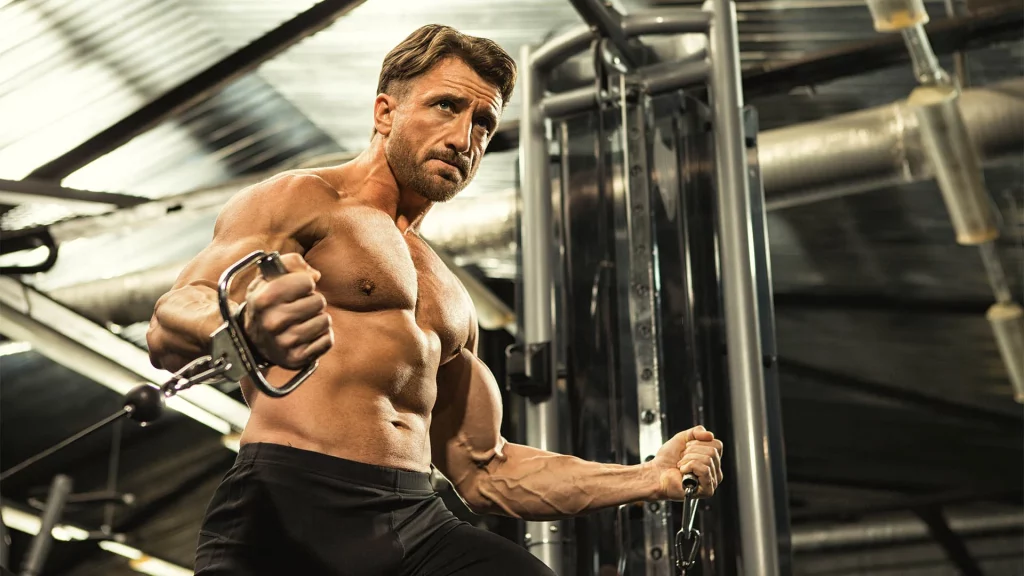Have you ever reached for a heavy bag of groceries and felt a twinge of surprise that it seemed heavier than you remember? Or maybe you’ve noticed that keeping up with the kids (or grandkids!) leaves you feeling more winded than it used to. It’s a common feeling, and one that often gets chalked up to the simple, unavoidable fact of getting older.
For decades, we’ve been told a story that after 40, it’s all a slow, downhill slide when it comes to our strength and vitality. But I’m here to tell you that story is ready for a major rewrite.
It is absolutely, 100% possible to build muscle, increase your strength, and feel more powerful and energetic in your 40s, 50s, and beyond. This isn’t about recapturing your 20s; it’s about stepping into a new chapter with confidence and capability. Forget what you think you know about strength training—it’s not just for elite athletes or bodybuilders. It’s for you.
This guide will walk you through everything you need to know, from why it’s so important to the simple, practical steps you can take to get started today.
Why Bother? The Amazing Benefits of Strength Training Over 40
Before we get to the “how,” let’s talk about the “why.” Building and maintaining muscle after 40 isn’t just about looking toned. It’s one of the single best things you can do for your long-term health and happiness.
- Boost Your Metabolism: Muscle is metabolically active tissue, meaning it burns calories even when you’re at rest. As we age, our metabolism naturally slows down. Building muscle is your secret weapon to counteract this, making it easier to maintain a healthy weight.
- Build Stronger Bones: After 40, we begin to lose bone density, which can lead to osteoporosis. Strength training puts healthy stress on your bones, signaling them to rebuild and become stronger and denser.
- Make Everyday Life Easier: From carrying luggage on vacation to rearranging furniture or simply getting up off the floor with ease, having a strong body makes every physical task more manageable and less likely to cause injury.
- Balance Your Hormones: Strength training can help naturally boost levels of hormones like testosterone and human growth hormone, both of which are vital for maintaining muscle mass, energy, and overall vitality in both men and women.
- Improve Mental Health: The sense of accomplishment and empowerment that comes from getting stronger is a powerful mood booster. Exercise is a proven tool for reducing stress, anxiety, and symptoms of depression.
The Biggest Myths About Building Muscle After 40 (Debunked!)
Let’s clear the air. Many people are hesitant to start strength training because of some persistent myths. Let’s bust them right now.
Myth 1: “It’s too late for me. My body can’t build new muscle.”
Fact: While we do naturally lose muscle mass with age (a process called sarcopenia), it is completely reversible. Your muscles retain their ability to grow and adapt your entire life, as long as you give them the right stimulus.
Myth 2: “I’ll have to lift super heavy weights and I’ll get bulky.”
Fact: Getting “bulky” is actually very difficult and requires a specific, intense training regimen and a massive calorie surplus. For most people, strength training creates a lean, toned, and defined look—not a bulky one. The goal is functional strength, not massive size.
Myth 3: “I’m going to get injured.”
Fact: It’s actually the opposite. Strength training, when done with proper form, is one of the best ways to prevent injuries. It strengthens the muscles and connective tissues that support your joints, making you more resilient. The key is to start slow and focus on form over weight.
Myth 4: “I need to spend hours in a gym every day.”
Fact: Consistency trumps duration every time. An effective, full-body strength workout can be done in 30-45 minutes, just two to three times per week. That’s all it takes to see real, lasting results.

Your Beginner’s Blueprint: How to Get Started
Ready to begin? Here’s a simple, no-nonsense plan.
Principle 1: Focus on Compound Exercises
The most effective way to build strength is with compound exercises—moves that work multiple muscle groups at once. This gives you the most bang for your buck and mimics real-life movements.
Principle 2: Progressive Overload
This sounds technical, but it’s simple. To build muscle, you need to challenge it. Progressive overload just means making your workouts slightly more challenging over time. This could mean:
- Adding one or two more repetitions (reps).
- Using a slightly heavier weight.
- Doing another set.
- Resting a little less between sets.
The key is small, gradual increments.
A Sample Beginner’s Full-Body Workout
Perform this workout 2 or 3 times a week, with at least one day of rest in between (e.g., Monday, Wednesday, Friday). All you need is a pair of dumbbells. Choose a weight that feels challenging but allows you to complete the reps with good form.
- Goblet Squats (3 sets of 8-12 reps): Hold one dumbbell vertically against your chest. Stand with your feet shoulder-width apart. Lower your hips back and down as if sitting in a chair, keeping your chest up. Go as low as you comfortably can, then push through your heels to return to the starting position. (Works quads, glutes, hamstrings, core).
- Push-Ups (3 sets of as many reps as possible): If you can’t do a full push-up, start on your knees or by placing your hands on a wall or sturdy table. The principle is the same: lower your body until your chest is close to the floor/wall, then press back up. (Works chest, shoulders, triceps).
- Dumbbell Rows (3 sets of 8-12 reps per arm): Place one knee and the same-side hand on a bench or chair. Hold a dumbbell in the opposite hand, arm extended. Pull the dumbbell up towards your chest, squeezing your shoulder blade. Lower it with control. (Works back, biceps).
- Glute Bridges (3 sets of 12-15 reps): Lie on your back with your knees bent and feet flat on the floor. Squeeze your glutes and lift your hips towards the ceiling until your body forms a straight line from your shoulders to your knees. Hold for a second, then lower. (Works glutes, hamstrings).
- Plank (3 sets, hold for 30-60 seconds): Hold a push-up position (on your hands or forearms) and keep your body in a perfectly straight line from your head to your heels. Brace your core and don’t let your hips sag.
Principle 3: Don’t Forget to Rest
Your muscles don’t grow during your workout; they grow when you rest and recover afterward. That’s why taking rest days is non-negotiable! Aim for 7-8 hours of quality sleep per night, as this is when your body does most of its repair work.
Fueling Your Progress: The Role of Nutrition
You can’t build a house without bricks, and you can’t build muscle without protein. You don’t need a complicated diet, just a focus on a few key things:
- Prioritize Protein: Protein provides the building blocks for muscle repair and growth. Aim to include a good source of protein with every meal. Think chicken, fish, eggs, lean beef, Greek yogurt, lentils, beans, and tofu. A simple guideline is a palm-sized portion with each meal.
- Hydrate, Hydrate, Hydrate: Your muscles need water to function properly. Drink plenty of water throughout the day.
- Focus on Whole Foods: Fuel your body with nutrient-dense foods like fruits, vegetables, and whole grains. These provide the vitamins, minerals, and energy you need to power through your workouts and recover well.

Your New Chapter of Strength
Starting a strength training journey after 40 is not about fighting against aging. It’s about embracing a new way to live in your body—a way that is defined by strength, capability, and confidence.
Forget the myths and the idea that it’s “too late.” The best time to start was yesterday. The next best time is right now. Pick up a dumbbell, try a push-up against the wall, and take the first step. You might just be amazed at what you’re capable of.
What’s one small step you’ll take this week to get stronger? Share your plans in the comments below!
